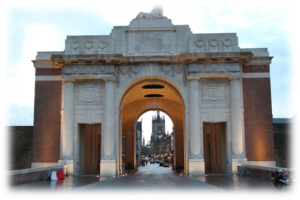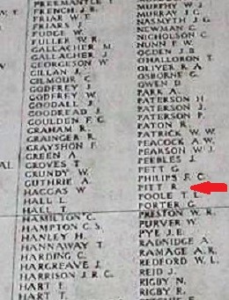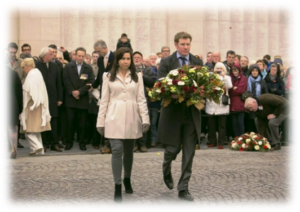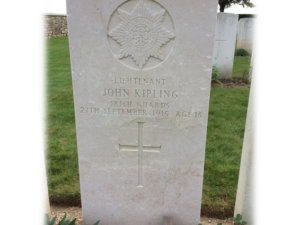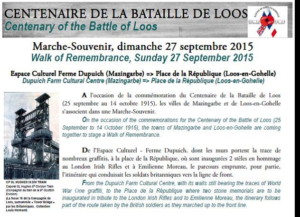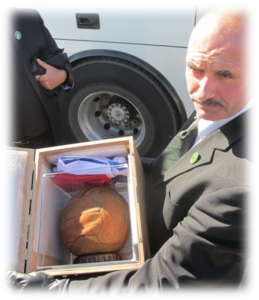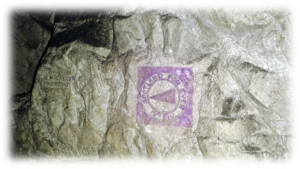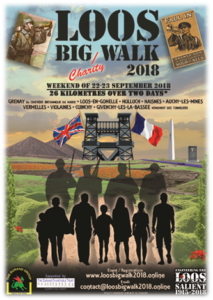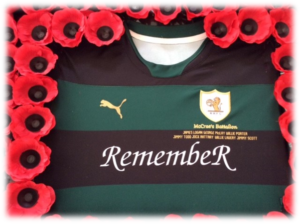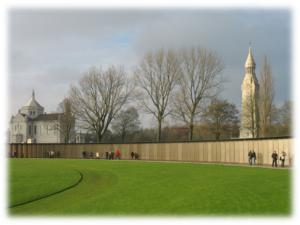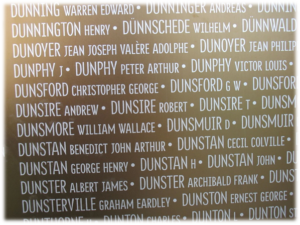With the onset of the 100th Anniversary of World War 1, Remembrance had a refreshing resurgence. The single period of a 100th Anniversary Commemoration would never replace the annual Armistice or Remembrance Day ceremony but it brought fresh light, new information and experiences to new generations.
Some things do not change. The 11 November ceremonies firmly underpin the desire for all of us to remember and re-assess the sacrifices of war. Even in the modern era where war is increasingly sophisticated our Armed Services still make very many sacrifices, including the ultimate sacrifice, for our continuing safety and the protection of our freedoms.
The following words of Robert Lawrence Binyon (1896-1943) are taken from the fourth verse of his poem, ‘For The Fallen’. These words, first published in The Times in September 1914, are still synonymous with Remembrance a century after they were written.
They shall grow not old, as we that are left grow old:
Age shall not weary them, nor the years condemn.
At the going down of the sun and in the morning
We will remember them.
Perhaps the most frequent and best example of the use of Robert Binyon’s words occurs at The Menin Gate at Ypres (Ieper). Every night at 20.00 they are repeated at a moving ceremony that takes place under the Menin Gate, where the Last Post Ceremony has become part of daily life. Local people are proud of this simple, but moving tribute to the courage and self-sacrifice of those who fell in defence of their town. The Menin Gate is one of four memorials to ‘the missing’ (no body found) in Belgian Flanders. On 30 January 2021, the 105th anniversary of Robert Dunsire VC’s death, the Last Post Ceremony took place for the 32,032nd time.
The Menin Gate at Ypres with St Martin’s Cathedral in the background
This daily act of remembrance started in 1928 under the Menin Gate Memorial. The Last Post Association has maintained the tradition of buglers, now from the local Volunteer Fire Brigade, who play ‘The Last Post’, the last tribute to the Fallen. It is a simple but moving ceremony. Among those whose names appear on the panels of and remembered at the Menin Gate is Kate Dunsire’s brother, Ralph Pitt (serial number 7756) of the Scots Guards, who was a regular soldier and deployed to Belgium when World War I broke out. His body was never found and his date of death is recorded as 11 November 1914.
Ralph Pitt’s name amongst fellow Guardsman who have no known grave
On 3 November 2013, I was among those who gathered for the Last Post Ceremony. After wreaths had been laid by previous Nobel Peace Prize Winners, a 30-year-old Australian, Corporal Daniel Alan Keighran VC, stepped forward to lay a wreath. Corporal Keighran VC was awarded the Australian VC for actions carried out at Derapet, Uruzgan Province, Afghanistan, in 2010, and invested with the Victoria Cross for Australia by Her Excellency the Governor General of Australia at Government House, Canberra on 1 November 2012. With the issuing of letters patent by the Queen on 15 January 1991, Australia became the first Commonwealth Country to institute a separate Victoria Cross award in its own honours system. Although it is a separate award, the Victoria Cross for Australia’s appearance is identical to its British counterpart.
Corporal Daniel Alan Keighran VC prepares to lay a wreath at Menin Gate
The Commonwealth Graves Commission (CWGC) cares for the graves of 1.7 million men and women from Commonwealth forces who died in World War I and World War II (www.cwgc.org). There are 23,000 cemeteries at locations throughout the world. The Commission’s work is funded by six nations: the UK, Canada, Australia, New Zealand, South Africa and India. These cemeteries and graves are maintained impeccably and there are cemeteries of many nations in the area around Loos-en-Gohelle, as bodies were not usually repatriated.
In January 2016 I made a short trip to Mazingarbe Communal Cemetery. My principal objective was to mark the 100th Anniversary of the death of Robert Dunsire VC. I would always take such an opportunity to walk round the Communal Cemetery and its Extension to look at all the CWGC gravestones while trying to imagine the stories behind the name. These stories are still living memories for many families. Over time I have visited Indian, Canadian, Portuguese, French, German and many other national Cemeteries that proliferate this area of Pas de Calais but it is still the story of Robert Dunsire VC and his family that captivates me most.
On my 30 January 2016 visit, I laid a personalised wreath on behalf of the family and all those who attended the Commemorative Service and Unveiling at Buckhaven just 4 months earlier. I had decided I would play 2 pieces of music which were synonymous with the story of Robert. The first was ‘See The Conquering Hero Come’ and Flowers of The Forest’. I took the following short video at the graveside to remember that particular slightly damp and blowy visit.
This is the CWGC headstone has been erected to the memory of a very young 18 years-old soldier who was killed at Loos and was to be remembered in a TV movie nearly 100 years after the incident that killed him. That soldier was Lieutenant John Kipling, aged 18, of the Irish Guards, the son of the writer and poet Rudyard Kipling. Lieutenant Kipling’s death was originally the basis for a play, written by David Haig, in 1997. It was then made into biographical film that was released in November 2007 – My Boy Jack. In the film, John Kipling was played by Daniel Radcliffe. In 1916, Rudyard Kipling had written a poem entitled ‘My Boy Jack’ for Jack Cornwell, who at 16 was the youngest ever recipient of the Victoria Cross.
Lieutenant Kipling is buried at St Mary’s Advanced Dressing Station Cemetery at Haisnes. The Cemetery is on the road between Vermelles and Hulluch to the north of Loos-en-Gohelle,
The day after the Commemoration Events for Robert Dunsire VC in Buckhaven, Fife I had driven through the night to enjoy the privilege of participating in the 2015 Battle of Loos Centenary Walk of Remembrance Memorial Walk. It was yet another opportunity to pay homage to Robert Dunsire VC after an early visit to his grave to lay a wreath.
I had the unexpected opportunity to witness the Ceremony of remembrance for the London Irish Rifles at Dud Cemetery. As participants left their bus, I was fortunate to catch another piece of Loos history when I took this photograph of the ball that featured in the wonderful book – The Footballer of Loos (published by History Press in 2009) – by Ed Harris. In this book, Ed Harris tells the story of Rifleman Frank Edwards kicking a ball towards the German trenches. Members of the 47 Division’s 1st Battalion of the London Irish Rifles joined in to pass the ball amongst themselves as they pushed on beneath a cloud of gas released by the British troops to signal the start of the Battle of Loos on 25 September 1915.
More can be found about this story by reading Ed’s excellent book and at: https://www.theworldwar.org/explore/collections/spotlight/loos-football
On a subsequent Loos Big Walk in 2018, we had the privilege of accessing World War 1 Tunnels that became a feature of the Front after the Battle of Loos as the battlefront moved increasingly underground. Thanks to the Durand Group we had the privilege of a guided tour walk through Mac’s Shaft, an underground tunnel in the Hulluch Sector, followed by access to the private ground at Hohenzollern Redoubt which featured in Robert Dunsire VC’s frontline activity in January 1916.
15 Division Soldier leaves their stamp underground in Mac’s Shaft
When war broke out in 1914, many thousands of men were inspired by the words of Sir Arthur Conan Doyle to fight for their country: ‘If a cricketer had a straight eye, let him look along the barrel of a rifle … if a footballer had strength of limb let them serve and match in the field of battle’.
Scotland’s example of a footballer’s battalion was McCrae’s 16th Battalion, the Royal Scots, that included seven players from Raith Rovers from Kirkcaldy in its midst when it headed for France and finally to the Somme. To mark the Centenary of the contribution of these 7 players, Raith Rovers produced a ‘remembrance strip’ in the Royal Scots colours. I had the Raith players’ names embroidered into the strip before it was made into a wreath at Lady Haig’s Poppy Factory at Warriston, Edinburgh. During my May/June 2016 ‘Walk of Remembrance’ – In Their Footsteps never in Their Shoes – in which I walked the route taken by Robert Dunsire VC and my maternal grandfather to the front at Loos-en-Gohelle. From Loos I continued on with my walking pal, Brian, to Contalmaison to be received by the lady Mayor who accompanied us to lay this special wreath at the McCrae Battalion’s Monument. Following a generous reception at Contalmaison, we walked on to Thiepval at The Somme in the footsteps of my wife’s paternal grandfather who served with the Black Watch in World War 1 and was wounded at The Battle of The Somme in 2016.
The most comprehensive 21st Century ‘symbol’ of Remembrance that I was to experience is the ‘Ring of Remembrance’ or ‘Anneau’ to the south of Loos-en-Gohelle. The memorial was built beside the imposing national military cemetery of Notre Dame de Lorette in the north of France – the site of the three Battles of Artois. It honours 576,606 soldiers of 40 nationalities who died in World War I battles in the north Pas-de-Calais area.
The Anneau comprises 500 3-metre-tall metal panels set on a 350-metre-long elliptical structure of concrete and stainless steel, some of which is raised off the ground – a symbolic reminder and warning of the precariousness of peace. Of these panels, 499 each bear the names of around 1,200 soldiers, who fell between 1914 and 1918, while the 500th is blank for any names yet to be discovered.
Inside the imposing Ring of Remembrance or Anneau at Notre Dame de Lorette
Uniquely for a war memorial, the names are listed in alphabetical order rather than by rank or nationality, to evoke, in the words of its designer Philippe Prost, a sense of ‘posthumous fraternity’, to reinforce post-war unity among countries that used to be enemies, and to stress a loss that goes beyond national boundaries.
Robert Dunsire is remembered as one amongst many at Notre Dame de Lorette
The monument – which also symbolises eternity and the cycle of life and death – was inaugurated by French President François Holland on Armistice Day 2014.
Remembrance has continued in the 21st Century in many forms and modern ways. Many exhibitions that I have attended in Methil, on the MAC Bus of OnFife, at Edinburgh Castle, in Pas de Calais in Northern France and in Belgium have awakened my awareness and magnified my understanding of the sacrifices of past and today’s generations. My interactions with my own Naval Reserve serving nephew and the team at Lady Haig’s Poppy Factory in Edinburgh have only enhanced my understanding of the impact of service of today’s Armed Forces. Attendance at one ceremony on one occasion every year is not sufficient. We should always remember our Armed Forces with pride in their actions on our behalf.
The wearing of the British symbol of the poppy and the French with their bleuet (cornflower) are still important reminders of the impact of war. The funds raised by the sale of the poppy and the bleuet contribute to the ongoing support of our current Veterans.
In remembering Robert Anderson Dunsire VC we remember the Many.
